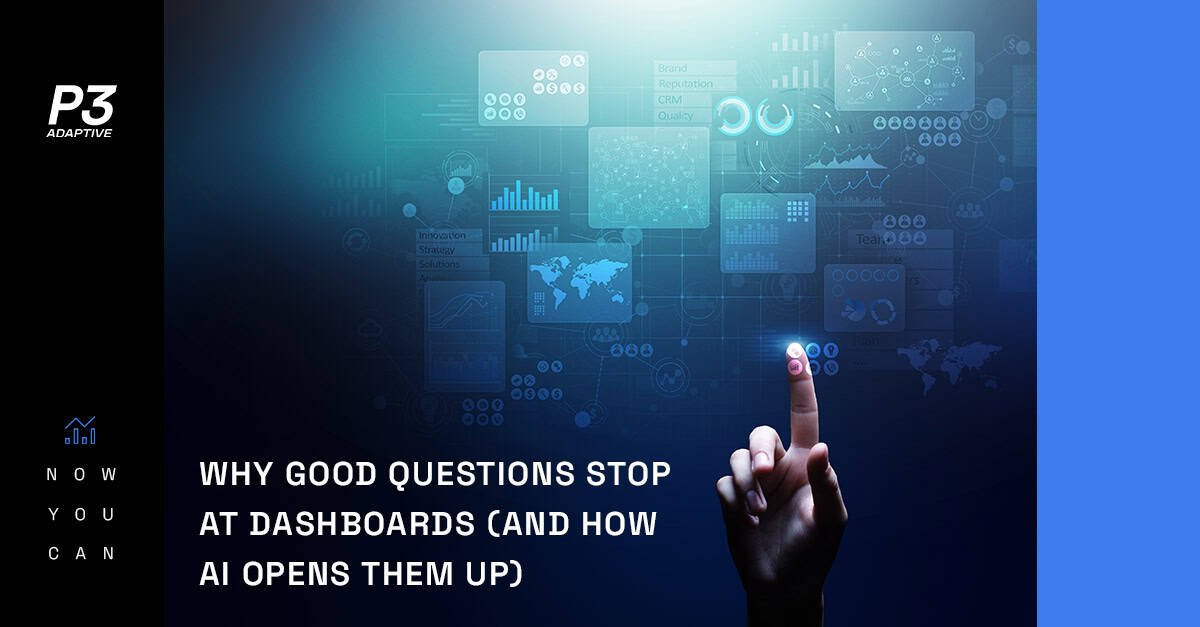
When every new question feels like a new project, curiosity gets buried.
Dashboards look great in demos. The charts sparkle, the filters line up neatly, and the presenter makes it look effortless. But when the spotlight shifts to the end user, something subtle happens: the questions stop.
I’ve seen it firsthand, long before I joined P3. Back then, when I was building a model or writing DAX live in front of a CEO, the questions poured out. “What about this segment? Can we break it down by customer type? What happens if we only look at the post-COVID period?” That back-and-forth was electric — curiosity fueling the build in real time.
But once the dashboard was “done” and handed over, the energy always faded. Leaders started to believe that every new question meant another round of development. Another scope call. Another invoice. So instead of chasing answers, they settled for what was already there.
The unspoken lesson? Dashboards aren’t places for open questions. They’re places for tracking predetermined metrics — static answers that slowly train leaders to stop asking for more. And that’s where BI loses its spark.
The Filter Paradox
Filters were supposed to be BI’s liberation. One dashboard could answer a hundred different questions. Pick your date, pick your product, pick your region — freedom at last.
But that freedom came at a price: every question had to be translated into filter logic before it could be answered. And translation is slow. Worse, it’s intimidating.
Instead of curiosity flowing straight into clarity, it detours through a maze of technicalities. Was that “sales” with returns removed or without? Does this date filter cascade across visuals or not? Every misstep chips away at trust in the dashboard.
I’ve watched this dynamic play out too many times. The people who “get” filters become the gatekeepers, while everyone else learns to keep their questions to themselves. Training doesn’t solve it. You can’t train people to love friction.
The paradox is brutal: the thing that was supposed to make BI flexible is the very thing that made it brittle.
Natural Language as the Universal Filter
This is where things finally change.
AI chat has blown past filters like they were standing still. You don’t have to bend your thinking into drop-down logic anymore — you just ask the question the way it naturally forms in your head. “Where do we rank if we only look at the post-COVID period?” And the system can piece it together instantly.
Even better, conversations can carry context that was never in the model to begin with. “Oh, by post-COVID, you mean starting in 2020 when we switched supply chain strategies? Got it.” Good luck building a reusable filter for that nuance. In a chat, it’s just the next line of conversation.
Here’s what excites me most: conversations with the model don’t just answer questions faster. They encourage more questions. When the fear of “this will take another build” disappears, curiosity comes roaring back. And when curiosity flows, insights multiply.
Filters freeze curiosity. Natural language sets it free.

What This Means for BI Strategy
This isn’t a minor UX tweak. It’s a tectonic shift in how BI delivers value.
Portfolios of fifty dashboards? They’re going to shrink. You won’t need endless prebuilt slices and variations anymore. Instead, you’ll need fewer polished dashboards, sitting on top of deeper, stronger semantic models.
And here’s the catch: natural language doesn’t replace the model. It leans on it harder than ever. AI doesn’t conjure definitions out of thin air. It depends on the relationships, measures, and logic built into the model. If that foundation is weak, the conversation will be too.
I’ve seen organizations try to skip this step — to bolt shiny AI features on top of wobbly data models — and the result is always the same: mistrust. People stop believing the answers, and the whole initiative stalls.
The lesson is clear: the future belongs to teams that invest in semantic models and treat them as the backbone of BI.
And the vendors know it too. Microsoft’s Power BI Copilot now lets you chat directly with your data, skipping filters entirely. That’s not a gimmick. It’s the new normal.
Where Do You Go From Here?
At P3 Adaptive, we’ve been preparing for this moment all along. Before natural language tools made headlines, we were already building the kind of semantic models that make them work. Clean definitions. Trusted logic. Business-first design.
Power BI Copilot and AI aren’t replacing that work — they’re amplifying it. They’re proving what we’ve always believed: BI should feel like a conversation, not a chore.
And here’s the part I love — this shift finally puts the power back where it belongs: with the people asking the questions. No more trained helplessness. No more “sorry, that’ll take another build.” Just questions flowing into answers, at the speed of curiosity.
The companies who thrive in this new landscape won’t be the ones with the flashiest dashboards. They’ll be the ones with solid foundations and partners who know how to bridge the gap between business language and data logic.
Filters had their time. The future belongs to curiosity without friction. And if you’re ready to stop burying good questions in filter panels, we’re ready to help you build what comes next.
Get in touch with a P3 team member